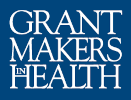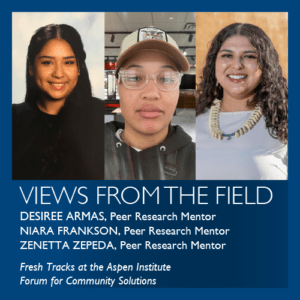Desiree Armas, Peer Research Mentor, Fresh Tracks at the Aspen Institute Forum for Community Solutions
Niara Frankson, Peer Research Mentor, Fresh Tracks at the Aspen Institute Forum for Community Solutions
Zenetta Zepeda, Peer Research Mentor, Fresh Tracks at the Aspen Institute Forum for Community Solutions
Interviewer: Miranda Wesley, Grantmakers In Health
Building upon a previous conversation with Juan Martinez of the Aspen Institute and Cynthia Weaver of The Annie E. Casey Foundation on their collaboration on the Youth and Young Adult Well-Being project, the following Q&A features three paid youth consultants who are leading the research initiative as the Youth and Young Adult Well-Being core team. Each team member represents a different cultural affinity group in the well-being project: Desiree Armas from Latine Bienestar, Niara Frankson from Black Expressions of Well-Being, and Zenetta Zepeda from American Indian/Alaska Native.
Formed in 2023 from the initiative of youth consultants and researchers Armas, Frankson, and Zepeda, the core team serves as a crucial link between the affinity groups and the adult planning team. They advocated not only for youth involvement in the research and implementation phase but also in the planning stages, making youth engaged and involved in every stage of the project. They provide guidance, make informed decisions, and actively contribute to the planning, codesign, and facilitation processes, aligning with the project’s evolving needs and capacity. The Youth and Young Adult Well-Being core team collaborates and meets closely with the planning team—because nothing is created for youth without youth.
What were the key findings of the youth-led participatory action research project?
Niara Frankson: Young people are more than capable of answering questions and making meaning of the world they live in. And for this particular project, young people’s understanding and framing of well-being are reflective of their larger communities. When young people feel like they’re thriving socially, mentally, and that they have economic opportunities, it can be an indication of how everyone else in society feels. We are more interconnected than we are led to believe, and well-being is collective.
Zenetta Zepeda: The key finding to this research is that the leading experts on youth-led participatory research are in fact the youth themselves. There is no better scientist than those who are driven to create change because they have lived through the necessity to do so. We are the experts on our well-being, and we are the best advocates for the needs of other youth.
How can philanthropy best support and show up for American Indian/Alaska Native (AIAN), Black, and Latinx youth’s well-being and mental health?
Niara Frankson: I sincerely believe that philanthropy is a means to redistribute wealth and support communities that are not seen as a priority by local, state, and federal government. Programs that serve young, marginalized folks are often first to the chopping block when budgets are considered “bloated.” These are usually programs that help young people discover interests and talents, help give them guidance and community, expand their experiences, and help pour into them as members of society. The best thing philanthropy could do is continue to fund services, projects, and programs that support the interests of the most marginalized people, young people as a whole, and especially young people who are American Indian/ Alaska Native, Latine, Black, and Asian.
How did arts-based expression serve as a new way to collect data on well-being?
Desiree Armas: Painting is fun! Our affinity group wanted to use something tangible, something participants could do with their hands as we thought about well-being together. We felt like painting was a way for folks to answer our questions, especially an abstract one like “What does well-being look like to you?” that is natural and relaxing. Afterward, folks got to keep their paintings, and we used those images to supplement their explanations of well-being. There were ideas and beliefs that our participants struggled to flesh out and having them paint their answer instead of just saying it allowed them to ground themselves in their response. Painting cemented the effectiveness of our methods. Music was used too. One of the researchers on the team is also a recording artist, and they took our findings and produced a song. As a team, we used that song to help guide us as we transitioned into the analysis phase of the project. By incorporating elements of our participant’s reflections in song form, we made it accessible to other young Latine people to connect and hear each other as we all thought about well-being.
What have been your favorite aspects of this project so far?
Zenetta Zepeda: When collecting data through a Western scientific lens, one studies through scientific and evidence-based practices, especially in STEM-based fields. Yet, throughout this project, the approach differed because it came from lived experiences gained through ancestral knowledge, which is another scientific lens. Conducting research like ours changes the stigmas and narratives surrounding validated science and, in return, evolves the scientific approaches in all fields of study. In essence, our protocols advance the scientific approach, which has been my favorite experience.
Desiree Armas: This project has connected me to a community that values my experience as expertise. Before becoming a part of the Well-Being project, I couldn’t fathom calling myself an expert on anything, so it’s been wonderful to surround myself with revered elders and other young minds who validate my experiences. It’s made me feel so empowered to be proactive in helping heal my community. And of course, this project was my introduction to the concept of YPAR (youth participatory action research). I’ve come to see just how brilliant young people are, regardless of age or education level.
What are the future steps of this project?
Niara Frankson: With every generational shift, I hope people will update the tool to reflect the times, to reflect the pop culture references and memes, and to reflect their priorities. I hope service providers, educators, and communities use the project to better understand young people of color. I hope this project is a reference for future work around collective healing, intergenerational collaborations, and human well-being and happiness.
Zenetta Zepeda: Well-being is fluid yet resilient alongside those for whom we started this research. Our research has shown itself to be a tool for understanding our own communities as well as other communities of diversity. Our protocol and research are just the start of the new generation of scientists that can begin to implement change for the future of people of color by the future themselves.

